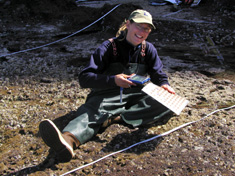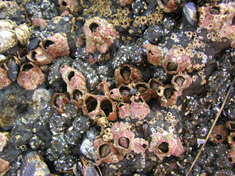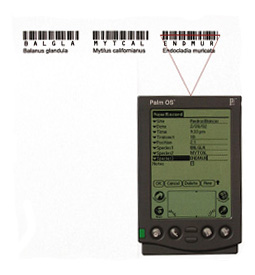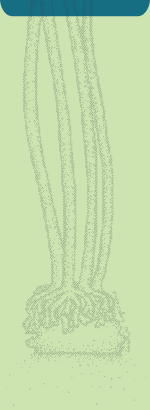Point Contact
 Each transect is surveyed using the point intercept method. At least 100 points per transect are sampled.
At each point three organisms are identified. This results in approximately 3300 data points per site.
Sampling intervals are adjusted with respect
to topographic features and size of the bench. If a transect is 20m long the interval between points
is 20cm.
Each transect is surveyed using the point intercept method. At least 100 points per transect are sampled.
At each point three organisms are identified. This results in approximately 3300 data points per site.
Sampling intervals are adjusted with respect
to topographic features and size of the bench. If a transect is 20m long the interval between points
is 20cm.
The organism that falls directly under each point is recorded first. Then the next two closest, but
different organisms are recorded. If no second and/or third organisms are found, "none" is recorded.
When an organism is located in a pool, on a cobble or boulder it is also recorded.
 Organisms living on another species are recorded as 'epibionts' and the organism they occur on is
recorded as 'host.'
Some examples of host organisms are mussels, coralline algae, barnacles,
and colonial worms. The letters 'A', 'B', and 'C' are assigned to identify them
as layers of organisms. A 'layer' is defined as a portion of an organism that is draped across another
organism, and is not attached to the substrate directly below the point being sampled.
For example, an algal frond draped across a barnacle would be recorded as "algae-A, barnacle-B."
If a organism under a point cannot be identified in the field, we assign it an
"unknown" number and collect a sample to identify it in the lab.
Organisms living on another species are recorded as 'epibionts' and the organism they occur on is
recorded as 'host.'
Some examples of host organisms are mussels, coralline algae, barnacles,
and colonial worms. The letters 'A', 'B', and 'C' are assigned to identify them
as layers of organisms. A 'layer' is defined as a portion of an organism that is draped across another
organism, and is not attached to the substrate directly below the point being sampled.
For example, an algal frond draped across a barnacle would be recorded as "algae-A, barnacle-B."
If a organism under a point cannot be identified in the field, we assign it an
"unknown" number and collect a sample to identify it in the lab.
Data Collection with Handheld Computers
 Palm pilots are used to expedite data recording and entry. Each palm pilot is outfitted with a
bar code scanner which is used to scan off a laminated
data sheet. On the sheet is a list of common organisms and their associated barcode.
Blank barcodes allow less common organisms to be entered by
hand. Upon returning from the field, data are quickly downloaded to a database. For more information
on data collection using handheld computers go to the
Jalama project page.
Palm pilots are used to expedite data recording and entry. Each palm pilot is outfitted with a
bar code scanner which is used to scan off a laminated
data sheet. On the sheet is a list of common organisms and their associated barcode.
Blank barcodes allow less common organisms to be entered by
hand. Upon returning from the field, data are quickly downloaded to a database. For more information
on data collection using handheld computers go to the
Jalama project page.
















